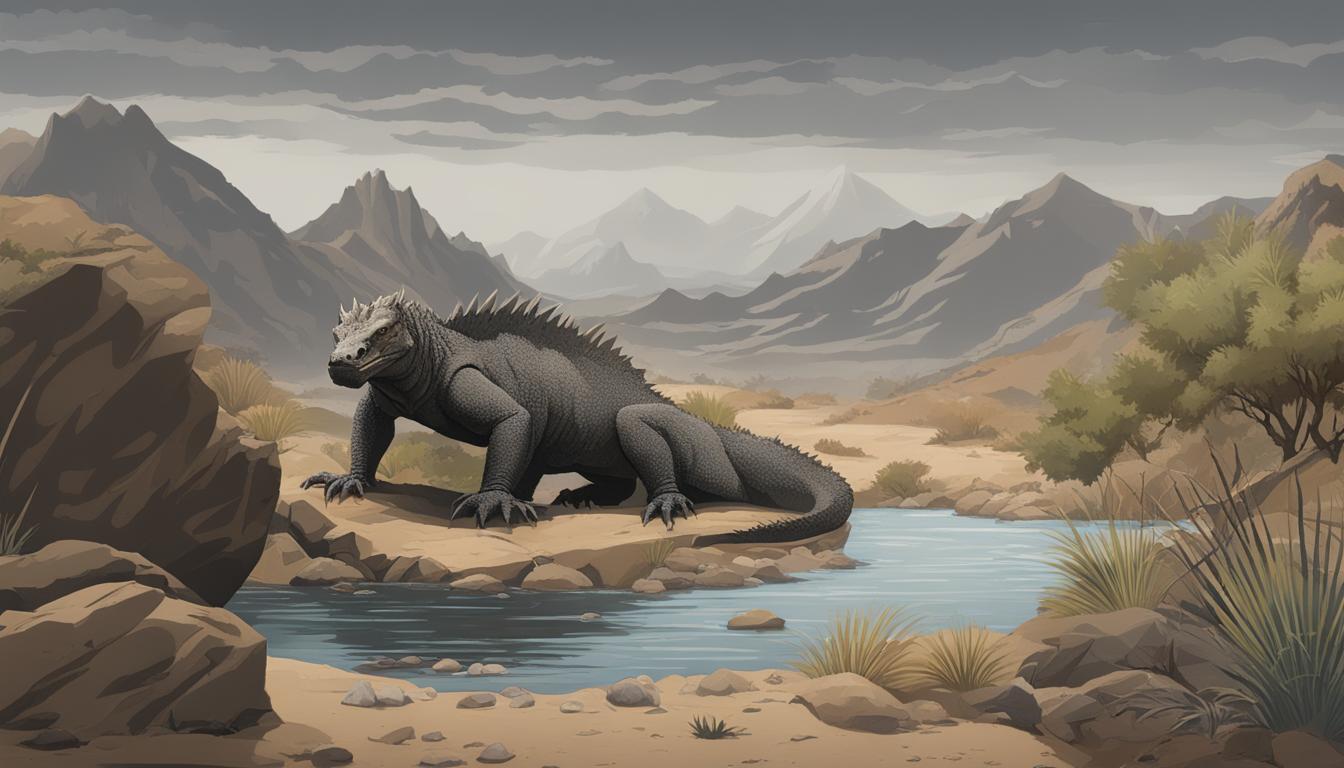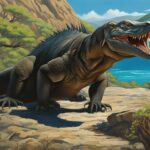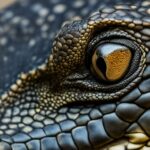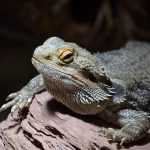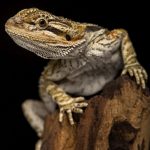Welcome to the fascinating world of Komodo dragons, where they roam freely in their natural habitat. In this article, we will explore the enchanting environment that these incredible creatures call home and discover the unique living conditions that have shaped their existence.
Found in the remote Indonesian islands of Komodo, Rinca, and Padar, as well as parts of Flores, the Komodo dragon’s habitat is as diverse as it is awe-inspiring. These islands, collectively known as the Komodo National Park, were established in 1980 to safeguard the dragons and preserve their precious ecosystem.
Characterized by hot and dry climates, with an average temperature of 80°F year-round, the Komodo dragon’s natural habitat comprises savannas, forests, and even arid deserts. These resilient creatures have adapted perfectly to their surroundings, making them the apex predators of their territories.
Feeding on large prey such as Timor deer, water buffalo, monkeys, and wild boar, the Komodo dragon’s hunting strategy relies on ambush and raw strength. Their unique venomous bite aids in incapacitating their prey, ensuring a successful hunt.
Thanks to the conservation efforts in Komodo National Park, the population of these magnificent creatures has been stabilized. However, challenges like habitat loss and declining prey populations continue to threaten their survival. It is essential for us to understand and appreciate the importance of protecting their habitat for generations to come.
Komodo Dragon Natural Habitat and Distribution
The Komodo dragon is native to the remote Indonesian islands of Komodo, Rinca, Padar, and parts of Flores. These islands make up the Komodo National Park, which was established in 1980 to protect the unique ecosystem of the dragons. The park provides a suitable habitat for the Komodo dragons, allowing them to thrive in their natural environment.
The Komodo dragons are well adapted to the hot and dry climate of their habitat, with an average temperature of 80°F year-round. They can be found across various ecosystems within the park, including savannas, forests, and even arid desert areas. Their ability to survive in different environments is a testament to their resilience and adaptability.
The Komodo dragon’s distribution is most densely populated on Komodo Island, which is where the species gets its name. However, they can also be found on Rinca, Padar, and parts of Flores. These islands provide the dragons with a diverse range of habitats to inhabit, allowing them to establish their territories and dominate as apex predators.
Table: Komodo Dragon Distribution
| Islands | Primary Habitat |
|---|---|
| Komodo | Savannas, Forests |
| Rinca | Savannas, Forests, Deserts |
| Padar | Savannas |
| Flores | Savannas, Forests, Deserts |
As strong swimmers, it is believed that the Komodo dragons have spread amongst the islands by navigating through the waters between them. However, on Flores Island, human development and habitat destruction have pushed the dragons to the southwestern edge. It is essential to protect their natural habitat and ensure their long-term survival in the face of these challenges.
Komodo Dragon Living Conditions
The Komodo dragons thrive in the hot and dry conditions of their habitat, which is characterized by an average temperature of 80°F year-round. These dragons are native to the Komodo National Park in Indonesia, where the climate is typically dry with limited freshwater availability outside of a brief monsoon season. Despite the harsh conditions, the Komodo dragons are well adapted to their environment.
They are most commonly found in the more vegetated savannas and forests of the islands, but they can also survive in arid desert areas. The terrain of their habitat consists of steep and rocky slopes, owing to the volcanic nature of the islands. These land features provide the dragons with suitable hiding spots and vantage points for their hunting strategies.
Within their ecosystem, the Komodo dragons primarily feed on Timor deer, water buffalo, monkeys, and wild boar. These prey species are abundant in the savannas and forests where the dragons reside. The dragons’ hunting strategy relies on their ability to ambush their prey and overpower them with their raw strength. Their serrated teeth and powerful neck muscles allow them to tear into the flesh of their prey with ease.
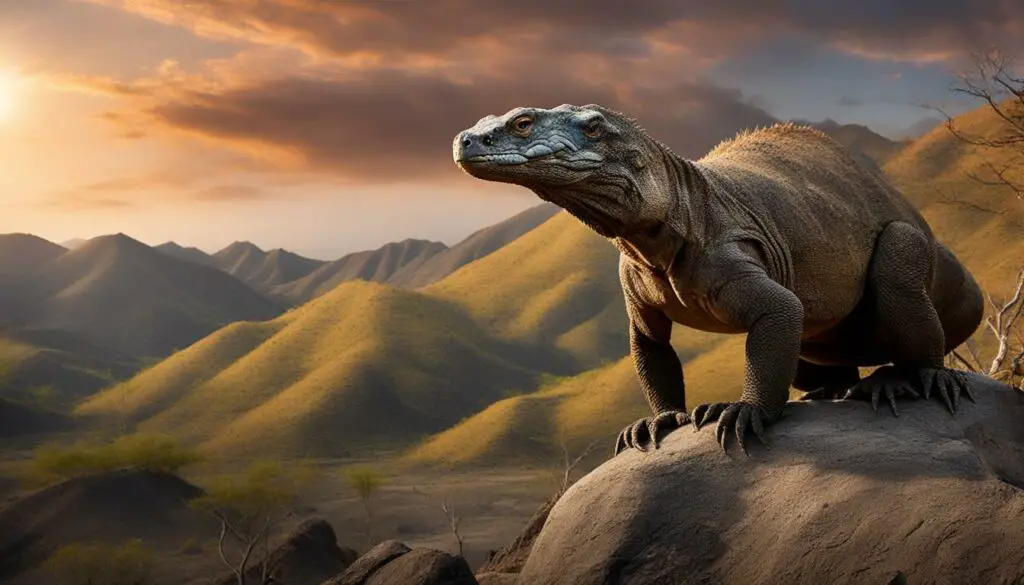
Table: Komodo Dragon Habitat Overview
| Habitat | Climate | Terrain | Prey |
|---|---|---|---|
| Savannas | Hot and dry | Vegetated with hiding spots | Timor deer, water buffalo |
| Forests | Hot and dry | Vegetated with vantage points | Monkeys, wild boar |
| Deserts | Hot and dry | Arid and challenging | Varies |
As apex predators, the Komodo dragons play a crucial role in maintaining the balance of their ecosystem. Their adaptation to the hot and dry conditions, along with their unique hunting strategies, allows them to thrive in their habitat despite the challenges it presents.
Komodo Dragon Predator and Prey Dynamics
When it comes to the natural hierarchy of the Komodo dragon’s ecosystem, these magnificent creatures reign supreme as apex predators. Their territories encompass forests, grasslands, and deserts, where they dominate as the largest and most formidable creatures. While juveniles learn to hunt smaller prey such as insects, lizards, and small mammals, the adult dragons turn their attention to larger animals like indigenous Timor deer, water buffalo, monkeys, and wild boar. Their hunting strategy revolves around stealth and power, relying on ambush techniques rather than chasing their prey.
Once a dragon has selected its target, it will wait patiently for the opportune moment to strike. With a venomous bite that weakens the prey, the dragon can easily overpower its victim using sheer strength. This unique hunting technique is further aided by serrated teeth and powerful neck muscles, allowing the dragon to tear into the flesh of its prey. Interestingly, Komodo dragons are capable of consuming up to 80% of their body weight in one sitting. After a successful hunt, they can go without eating for about a month.
To further understand the predator and prey dynamics of Komodo dragons, the following table outlines some key facts:
| Prey | Hunting Techniques | Predator-Prey Ratio |
|---|---|---|
| Indigenous Timor Deer | Ambush and overpower | High |
| Water Buffalo | Ambush and overpower | Moderate |
| Monkeys | Ambush and overpower | Moderate |
| Wild Boar | Ambush and overpower | Moderate |
As the table demonstrates, the Komodo dragon’s hunting strategy remains consistent across a variety of prey animals. Their ability to adapt and thrive in their environment is a testament to their remarkable biology and survival skills. By maintaining their status as apex predators, Komodo dragons play a crucial role in maintaining the balance and health of their unique ecosystem.
The Komodo Dragon’s Venomous Bite
One of the most fascinating aspects of the Komodo dragon’s hunting technique is its venomous bite. Recent studies have revealed that these mighty creatures have venom glands in the back of their throats. This venom acts as an anticoagulant, preventing blood clotting and causing the prey to suffer from blood loss. The dragons use their incredible sense of smell to track down wounded prey, and once they have located their target, they ambush it with a swift and venomous bite. This venom weakens the prey, making it easier for the dragon to overpower and consume.
The Komodo dragon’s venomous bite is a crucial component of its hunting strategy. By incapacitating its prey, the dragon ensures a successful kill and minimizes the risk of injury to itself. This venomous bite is just one example of the incredible adaptability and effectiveness of these creatures in their natural habitat.
The venomous bite of the Komodo dragon weakens and disorients its prey, making it easier to capture and consume. It is a testament to the dragon’s incredible hunting prowess and the unique adaptations it has developed over thousands of years in its harsh environment.
While initial research suggested that the bacteria in the dragon’s saliva played a role in killing its prey, the discovery of venom glands has provided a new understanding of the hunting techniques employed by these apex predators. This new knowledge underscores the ongoing importance of studying and conserving the habitats of these remarkable creatures.
| Aspect | Details |
|---|---|
| Venomous Bite | The venom acts as an anticoagulant, preventing blood clotting and causing the prey to suffer from blood loss. |
| Hunting Strategy | The dragons use their incredible sense of smell to track down wounded prey and deliver a venomous bite to weaken and incapacitate it. |
| Adaptability | The venomous bite is a crucial component of the dragon’s hunting strategy and allows for successful kills and minimal risk of injury. |
Komodo Dragon Reproduction and Life History
The life cycle of a Komodo dragon is fascinating and unique. Females have the remarkable ability to reproduce through parthenogenesis, meaning they can lay fertilized eggs without the involvement of a male dragon. This makes Komodo dragons the largest known vertebrates to reproduce in this way. The female lays clutches of approximately 20 eggs, burying them in the ground for incubation. After a period of 8 to 9 months, the hatchlings emerge in April.
When the young dragons hatch, they are vulnerable and primarily feed on insects. For their safety, they spend their early years in the safety of tree branches before descending to the ground as they mature. It takes nearly 10 years for them to reach maturity and become apex predators like the adults. Throughout their lives, Komodo dragons have a lifespan of about 30 years.
To illustrate the life cycle of a Komodo dragon, the following table provides an overview of the different stages and key milestones:
| Stage | Description |
|---|---|
| Egg laying | Females lay clutches of approximately 20 eggs |
| Incubation | Eggs are buried in the ground and incubate for 8-9 months |
| Hatching | Hatchlings emerge from the eggs in April |
| Juvenile stage | Young dragons primarily feed on insects and spend their early years in tree branches for safety |
| Maturation | It takes approximately 10 years for the dragons to reach maturity and become apex predators |
| Adulthood | Adult dragons have a lifespan of about 30 years |
Understanding the life history and reproduction of Komodo dragons is crucial for conservation efforts and ensuring the long-term survival of these magnificent creatures.
Conservation Efforts and Challenges
The Komodo dragon, being a vulnerable species, requires dedicated conservation efforts to protect its habitat and ensure its long-term survival. The Indonesian government has taken significant steps by establishing the Komodo National Park in 1980, which plays a crucial role in safeguarding the dragons and their unique ecosystem. This protected area encompasses the islands of Komodo, Rinca, and other smaller islands, providing a safe haven for the dragons to thrive.
However, the conservation of Komodo dragons faces several challenges. Habitat loss and degradation due to human development pose a significant threat to these magnificent creatures. As human populations and infrastructure expand, the natural habitats of the dragons are being encroached upon, leading to a decline in their numbers. Additionally, the decline of prey species, such as the indigenous Timor deer, further exacerbates the challenges faced by the dragons.
Climate change and rising sea levels also pose significant risks to the Komodo dragon habitat. The islands where they reside are vulnerable to the impacts of climate change, including increased temperatures, extreme weather events, and sea-level rise. These changes can disrupt the delicate balance of the ecosystem and threaten the survival of the dragons.
Threats to Komodo Dragon Habitat:
- Habitat loss and degradation due to human development
- Decline of prey species, such as the indigenous Timor deer
- Climate change and rising sea levels
To address these challenges, it is crucial to continue promoting sustainable practices and raising awareness about the importance of conserving the Komodo dragon and its habitat. Efforts to support ecotourism not only contribute to the local economy but also generate funds for conservation initiatives. By visiting Komodo National Park and witnessing the majesty of these creatures in their natural habitat, visitors can develop a deeper appreciation for the need to protect and preserve the Komodo dragon for future generations.
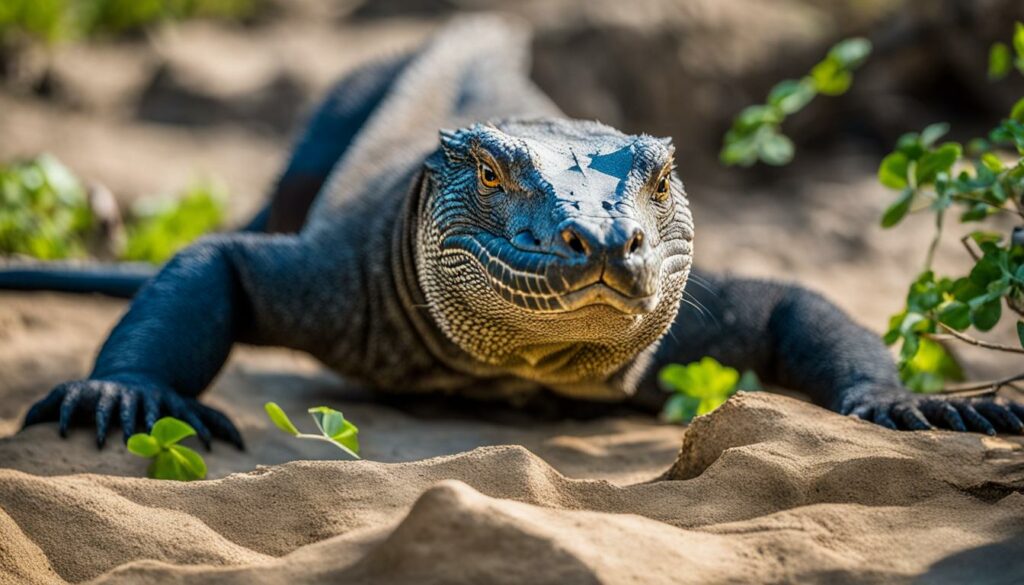
| Conservation Efforts | Challenges |
|---|---|
| – Establishment of Komodo National Park | – Habitat loss and degradation |
| – Implementation of measures to prevent poaching | – Decline of prey species |
| – Promotion of sustainable practices | – Climate change and rising sea levels |
| – Support for ecotourism |
Visit Komodo National Park and See the Dragons
If you’re fascinated by the majestic Komodo dragons and want to witness them in their natural habitat, a visit to Komodo National Park is a must. Located in the remote Indonesian islands of Komodo, Rinca, and Padar, this national park offers a unique opportunity to encounter these incredible creatures up close.
“Seeing the Komodo dragons in person was a truly unforgettable experience. Their size and power are awe-inspiring, and being able to observe them in their natural environment was a dream come true.” – Visitor testimonial
To embark on this adventure, you can start your journey from Labuan Bajo, the closest town to the park. From there, you can arrange boat trips that will take you on guided tours around the islands. It’s recommended to book tours that include early morning visits to the dragons, as they are most active during that time.
During your visit, it’s important to follow safety guidelines and respect the dragons’ natural habitat. While these creatures may appear docile, they are still wild animals and can be dangerous if provoked. Keep a safe distance and listen to the instructions of your guides to ensure a safe and memorable experience.
By visiting Komodo National Park, not only will you have the opportunity to witness the fascinating Komodo dragons, but you’ll also be supporting the conservation efforts and the local economy. The park’s success in promoting ecotourism has played a crucial role in the preservation of these magnificent creatures and their habitat.
So, if you’re ready for an adventure like no other, pack your bags and head to Komodo National Park. Witnessing the Komodo dragons in their natural habitat is a once-in-a-lifetime experience that you’ll cherish forever.
Conclusion
The Komodo dragon habitat in Komodo National Park and Flores, Indonesia, is truly remarkable. These majestic creatures have thrived in the harsh conditions of their environment and have become the apex predators in their territories. The establishment of the national park and conservation efforts have helped stabilize the population of Komodo dragons, but challenges still remain.
Habitat loss, declining prey populations, and the impacts of climate change continue to threaten the survival of these magnificent creatures. It is essential that conservation efforts are supported and sustainable practices, such as ecotourism, are promoted. By raising awareness and investing in the protection of their habitat, we can ensure the long-term survival of the Komodo dragon and preserve the unique ecosystem they call home.
Visiting Komodo National Park is an incredible opportunity to witness these spectacular creatures in their natural habitat. By following safety guidelines and booking tours that prioritize the well-being of the dragons, you can have a memorable and educational experience. Supporting ecotourism not only benefits the local economy but also contributes to the ongoing conservation efforts. Together, we can make a difference in protecting the Komodo dragon and preserving its habitat for future generations to enjoy.
FAQ
Where can I find Komodo dragons?
Komodo dragons are native to the Indonesian islands of Komodo, Rinca, and Padar, as well as parts of Flores.
What is the habitat of the Komodo dragon like?
The Komodo dragon can be found in various ecosystems, including savannas, forests, and deserts. They thrive in hot and dry climates, with an average temperature of 80°F year-round.
What do Komodo dragons eat?
Komodo dragons primarily feed on large prey such as Timor deer, water buffalo, monkeys, and wild boar.
How do Komodo dragons hunt?
Komodo dragons use ambush and raw strength as their hunting strategy. They wait in ambush for their prey and overpower it using their incredible strength.
Do Komodo dragons have venom?
Yes, Komodo dragons have venom glands in the back of their throats. Their venom acts as an anticoagulant, weakening their prey and aiding in their hunting strategy.
How do Komodo dragons reproduce?
Female Komodo dragons are capable of laying fertilized eggs without the involvement of a male, a process known as parthenogenesis.
Are Komodo dragons endangered?
Yes, Komodo dragons are listed as a vulnerable species on the IUCN Red List. Conservation efforts are being made to protect their population and habitat.
Where can I see Komodo dragons in their natural habitat?
The best place to see Komodo dragons in their natural habitat is at Komodo National Park in Indonesia. Organized tours can be arranged to see them up close.
Are Komodo dragons dangerous?
Komodo dragons can be dangerous if provoked. Visitors should follow safety guidelines and be cautious when encountering them.

